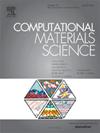在原子尺度上揭示温度对喷射物形成开始的作用
IF 3.3
3区 材料科学
Q2 MATERIALS SCIENCE, MULTIDISCIPLINARY
引用次数: 0
摘要
激波与自由表面上扰动的相互作用可以导致扰动的反转和增长,并最终从激波表面喷出物质射流,称为喷射微射流。本研究使用单晶Cu和Sn系统进行了大规模分子动力学(MD)模拟,以表征导致微射流形成的局部温度和压力梯度。在三个加载方向(沿[001]、[011]和[111]方向)和冲击压力范围从16 GPa到100 GPa的情况下进行了MD模拟,以了解凹槽顶点产生的温度对喷出物形成的作用。模拟结果表明,激波与凹槽的相互作用导致了温度的局部升高,从而导致凹槽顶点的局部软化和喷射微射流的产生。对于Cu系统,模拟表明,取向对激波结构、速度和局部软化的影响影响了低压下的喷射物形成。只有当凹槽顶点的温度高到足以引起局部软化(接近熔化温度)时,才会观察到喷射现象,并且射流速度随着冲击压力的增加而增加。相反,加载方向对于锡系来说是无关紧要的,因为在选择的压力下,材料在冲击压缩过程中会熔化。在Sn体系中,无论晶体取向如何,射流速度都是相似的。本文章由计算机程序翻译,如有差异,请以英文原文为准。

Unraveling the role of temperature on the onset of ejecta formation at atomic scales
Shock wave interactions with perturbations on a free surface can lead to the inversion and growth of the perturbation and eventual ejection of a jet of material, referred to as an ejecta microjet, from shocked surfaces. This study carries out large-scale molecular dynamics (MD) simulations using single-crystal Cu and Sn systems with a pre-existing groove to characterize the localized gradients in temperatures and pressures generated that render the microjet formation. MD simulations are carried out for three loading orientations (along the [001], [011], and [111] directions) and shock pressures ranging from 16 GPa to 100 GPa to understand the role of temperatures generated at the groove vertex on the formation of ejecta. The simulations suggest that the interaction of the shock wave with the groove results in a localized increase in temperatures, leading to localized softening at the groove vertex and the generation of an ejecta microjet. For Cu systems, the simulations suggest that the orientation effects on shock wave structures, velocities, and localized softening affect the ejecta formation at low pressures. Jetting is only observed when temperatures at the groove vertex are high enough to induce localized softening (close to melting temperature), and the jet velocity increases with shock pressure. In contrast, the loading orientation is rendered inconsequential for Sn systems due to the melting of the material during shock compression at the pressures chosen. The jet velocities are similar, regardless of crystal orientation in Sn systems.
求助全文
通过发布文献求助,成功后即可免费获取论文全文。
去求助
来源期刊

Computational Materials Science
工程技术-材料科学:综合
CiteScore
6.50
自引率
6.10%
发文量
665
审稿时长
26 days
期刊介绍:
The goal of Computational Materials Science is to report on results that provide new or unique insights into, or significantly expand our understanding of, the properties of materials or phenomena associated with their design, synthesis, processing, characterization, and utilization. To be relevant to the journal, the results should be applied or applicable to specific material systems that are discussed within the submission.
 求助内容:
求助内容: 应助结果提醒方式:
应助结果提醒方式:


